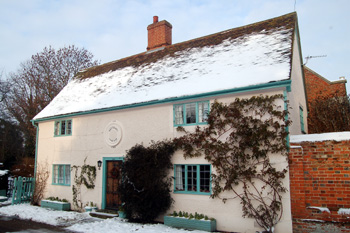326 Church Lane Cardington

326 Church Lane Christmas Eve 2010
326 Church Lane was listed by the former Ministry of Public Buildings and Works in July 1964 as Grade II, of special interest. A plaque outside notes that the house was built by John Howard in 1762 and restored by Samuel Howard Whitbread in 1928. It is constructed of colour washed roughcast over a timer frame and has an old clay tile roof. A modern lean-to extension stands at the rear.
We are fortunate that three surveys of the parish of Cardington from the late 18th century survive. The first of these was undertaken in 1782 by James Lilburne. He was the parish schoolmaster and later agent for Samuel Whitbread, who owned large estates in the parish and also the sole Enclosure Commissioner for the parish. He produced a list of all the inhabitants of the parish arranged by house and hamlet [P38/28/1]. This was published, with extensive analysis by County Archaeologist David Baker in 1973 as Bedfordshire Historical Record Society Volume 52.
Since publication a second list has been found [P38/28/2]. It carries revisions up to the year 1789. Sadly neither of these surveys includes a map. Finally, in 1794 Lilburne produced another survey [W2/6/1-3] and this one had a map with a key showing where each house was. One can use this to plot the houses of the previous surveys and this work was carried out by John Wood of Bedfordshire County Council’s Conservation Section in October 1982 [CRT130Cardington29].
The survey of 1782 [P38/28/1/2] shows that the house was occupied by widow Ann Preston, who was 67 years old. She died on 4th May 1787. Her nephew lived with her. He was Samuel Preston, a 25 year old wheelwright who died on 27th February 1786. Samuel’s wife was 25 year old Mary. The couple had one daughter at that stage, 1 year old Mary, who was later schooled by Friends – it is unclear whether this means the Society of Friends, or Quakers, or friends of the family. A son, Samuel, was born on 8th September 1782 and was also schooled by “Friends”. A third child, Sarah, was born on 22nd January 1785. In 1788 Mary and her children moved into 271 Bedford Road.
The Rating and Valuation Act 1925 specified that every building and piece of land in the country was to be assessed to determine its rateable value. Cardington, like most of the county, was assessed in 1927 and the valuer visiting 326 Church Lane [DV1/C116/4] found it owned by the Whitbread Estate and occupied by A. Sapell, who was the butler at Howard House. His accommodation comprised a parlour, living room and scullery, “a copper place” (for heating water) and two bedrooms made into three. The valuer commented: “very, very nice”.